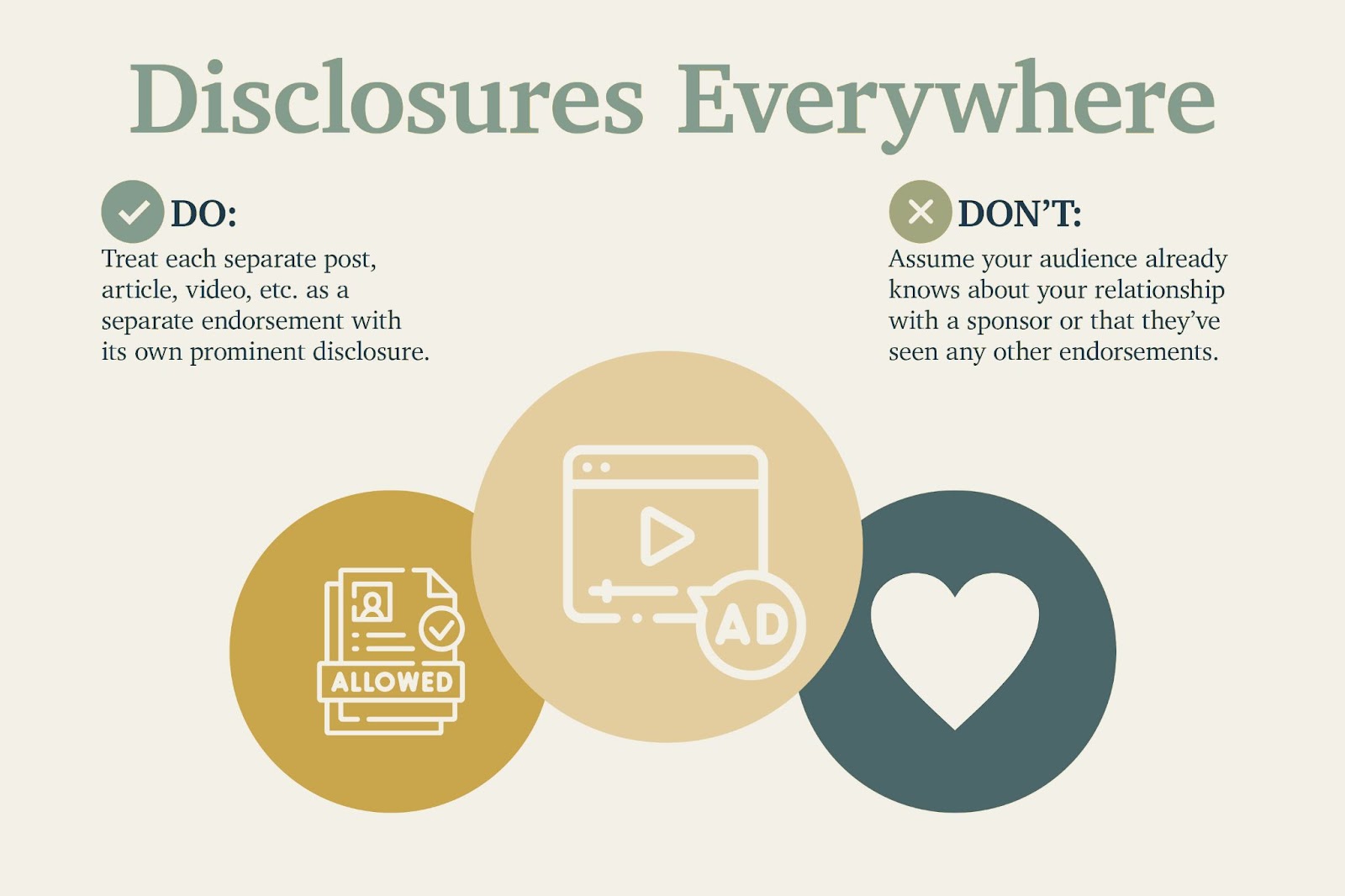Did you know that $5.7 billion was lost to investment scams in 2024 alone, many facilitated through misleading social media promotions? Or that a single celebrity influencer was fined over $1.26 million for failing to disclose a paid crypto endorsement?
The world of financial marketing is becoming increasingly dangerous, especially when it comes to influencer partnerships. With the FTC's significant guideline updates and enforcement actions ramping up across finance, banking, and investment sectors, the cost of non-compliance has never been higher.
But here's the reality: four out of five social media influencers still fail to properly disclose paid partnerships, putting both themselves and the brands they work with at serious legal and financial risk.
We've put together this comprehensive guide to help you understand what the FTC expects, what happens when those expectations aren't met, and how to protect your organization from costly compliance mistakes.
What are the FTC Guidelines for Influencers?

The FTC's guidelines for influencers are outlined in its Endorsement Guides, which were significantly revised in June 2023 for the first time since 2009. These guidelines advise how to advertise truthfully when using endorsements on any medium, including social media.
Key updates in 2023 strengthened requirements for influencers and brands: the FTC clarified what counts as a "clear and conspicuous" disclosure and emphasized that built-in platform tools (like "paid partnership" tags) might not be sufficient on their own.
The revised Guides explicitly cover newer formats – tagging brands, using virtual influencers, and posting on ephemeral media – all of which can be endorsements that require disclosure.
In a nutshell, the FTC expects influencers to disclose any material connection (such as payments or free products) in a way that is hard to miss and in the same format as the content.
Why the FTC Enforces Guidelines?
The FTC's mission is to protect consumers from deceptive advertising, and influencer marketing falls under this scope. Without proper disclosure, consumers can be misled into thinking an endorsement is a genuine, unbiased recommendation.
Data on consumer harm shows why enforcement is needed. Since 2021, 1 in 4 people who reported losing money to a fraud said it started on social media, and reported losses from scams on social platforms reached $2.7 billion in that period.
In 2024, U.S. consumers lost $5.7 billion to investment scams – a number inflated by deceptive online promotions and crypto "get-rich-quick" schemes often touted on social networks.
The FTC's guidelines aim to curb these losses by ensuring consumers know when they're seeing paid promotions. For example, in November 2023 the FTC sent warning letters to 12 health influencers for Instagram and TikTok posts that promoted products without adequately disclosing they were paid.
By enforcing these guidelines, the FTC works to prevent false advertising, restore fair competition, and ultimately protect consumers from fraud and unsafe or overhyped products.
What are FTC Influencer Guidelines (Fintech, Banking & RIA Challenges)
While all influencers must follow FTC rules, those operating in financial sectors face unique compliance challenges. Fintech companies, banks, and RIAs deal with products that are often regulated by additional laws, making compliant communication even more critical.
A key FTC principle is that endorsements must be truthful and not misleading – a high bar in finance, where a stray comment can be interpreted as an investment promise or legal advice. Influencers in fintech ("finfluencers") and finance brands must ensure that any claims about financial products are accurate, balanced, and include necessary disclaimers, on top of disclosing sponsorship.
Recent regulatory sweeps show how tricky this can be. In 2024, FINRA conducted a targeted compliance review of broker-dealers' use of financial influencers and found problems: at least one firm failed to reasonably supervise its paid influencers, whose social media promotions were not fair and balanced, violating communication rules.
Similarly, the SEC took action in August 2023 against Fundrise Advisors, an RIA, for its influencer program – the firm paid over 200 social media creators to solicit clients but did not ensure required disclosures to investors were provided, breaching SEC marketing rules.
These cases clearly show the compliance challenge: financial influencers must clearly disclose sponsorship and avoid any content that could mislead on matters like returns, fees, or risks. Because even one misleading post about a bank or an investment could lead to serious consumer losses.
Who Needs to Follow FTC Rules?
Anyone who is paid to endorse or promote a product/service – whether with cash or freebies – is expected to follow FTC disclosure rules. This isn't limited to celebrities; it includes YouTubers, Instagram creators, TikTokers, bloggers, and even employees or investors touting a company.
By 2025, an estimated 86% of U.S. marketers (at companies with 100+ employees) will use influencers to promote their products.
Compliance is particularly important for sectors like finance, as regulators pay close attention there. For example, if a financial advisor or RIA uses social media for client testimonials or endorsements, they not only have to follow SEC rules but also the FTC's truth-in-advertising principles.
Another thing, the FTC has clarified that brands and intermediaries are also responsible: companies hiring influencers must educate and monitor them to ensure compliance, since advertisers can be held liable for influencer missteps.
How Should Influencers Disclose Endorsements?

According to the FTC, disclosures should be clear, conspicuous, and in plain language. There's no one "magic phrase," but the message must effectively communicate that the content is an advertisement.
Common best practices include using words like "#ad", "#sponsored", or "advertisement" in social media posts. The disclosure should appear with the endorsement message itself, not hidden in a bio or a comments section, and it should be easily noticeable.
For example, in an Instagram caption, an influencer might say "Thanks to [Brand] for sponsoring this post! #ad" at the beginning of the caption – this is usually sufficient if it's prominent (Use simple and clear language that is hard to miss).
On platforms with character limits like Twitter/X, a short tag like "Ad:" or "#Ad" can do the job, possibly accompanied by the brand name for clarity.
The FTC explicitly warns against burying disclosures among hashtags or at the end of a long post where readers might skip over them.
In video content, an influencer should mention the sponsorship audibly and/or overlay a disclosure on the video, ideally in the first moments.
Recent studies show why clear disclosures matter: an analysis of over 100 million tweets found 96% of sponsored posts were not disclosed, and many consumers failed to recognize them as ads without a disclosure.
What is a Material Connection?
A "material connection" is any relationship between an influencer and a brand that could affect the credibility a viewer gives to the endorsement. This includes financial ties (payment, free products, affiliate commissions), personal relationships, or even stock ownership.
Essentially, if the audience might trust your opinion less if they knew you were being compensated, that connection is "material" and should be disclosed. The FTC requires disclosure of all material connections so consumers can weigh an endorsement with full knowledge of potential bias.
Why does this matter? Because material connections can significantly influence consumer behavior and trust. If not disclosed, consumers might mistakenly believe an endorsement is impartial.
In October 2022, Kim Kardashian was fined $1.26 million by the SEC for hyping up a cryptocurrency without revealing she was paid $250,000 for that promotion. The lack of disclosure meant her followers didn't know her "investment tip" was a paid ad.
Where to Place the Disclosure in Content?
Placement is critical – a disclosure must be hard to miss for the average consumer. The FTC advises that the disclosure be placed as close as possible to the endorsement message.
In a social media post, this means within the text or image/video of the post itself (not just on the user's profile or buried at the bottom). If an Instagram caption is long, the disclosure should appear before the platform's "See more" cutoff.
In a TikTok or Instagram Story, the influencer should superimpose the disclosure on the video/image, in a font and color that stands out, and ensure it stays on screen long enough to be read.
For videos, it's best to both say it out loud and show it on screen, ideally at the beginning. The FTC explicitly notes that disclosures may be missed if they appear only at the end of a video or only in the description text.
For influencers in fintech, effective placement might also include repeating the disclosure. For example, during a 30-minute live financial webinar, an RIA might periodically remind viewers, "As a reminder, this session is sponsored by [Brand]."
The FTC's updated guidance in 2023 even mentioned that some platform-provided tags might not be enough – for instance, just relying on YouTube's tiny "Includes paid promotion" notice might not suffice if an influencer doesn't also mention it in the video.
Examples of Effective Disclosure Practices
To illustrate, consider a few real-world scenarios of FTC-compliant disclosures:
- Instagram Post (Fashion Influencer): The influencer posts a photo of herself wearing a designer outfit that was gifted by the brand. In the first line of the caption, she writes, "Sponsored by @DesignBrand – they sent me this outfit and I absolutely love it! (#ad)" – before delving into her review of the product. This disclosure is upfront and uses clear terms, making the relationship obvious (Use simple and clear language that is hard to miss).
- YouTube Tech Review: A tech influencer creates a video reviewing a new smartphone that a company paid him to promote. At the start of the video, he says: "This video is sponsored by XYZ Corp. They provided the phone for free and are compensating me to share my experience with it." He also toggles YouTube's built-in "paid promotion" notification. This multi-pronged disclosure ensures no viewer misses the sponsorship disclosure.
- TikTok Finance Tip: A finfluencer on TikTok shares "5 tips to save money" in a snappy video, and one of the tips involves using a particular budgeting app with which she has a partnership. In the video itself, she uses TikTok's branded content toggle and also overlays text at the bottom from the start that says "#Ad for BudgetApp." She verbally mentions, "Tip 3 is brought to you in partnership with BudgetApp, who sponsored this video."
- Blog Post (Lifestyle): A blogger writes an article titled "Top 10 Kitchen Gadgets I Use Every Day," and some of the products are affiliate links. At the very top of the blog post, before the list, she includes a note: "Disclosure: I received free samples of some of these products and will earn a commission if you buy via my links. Opinions are my own."
What are the Consequences of Non-Compliance with FTC Guidelines?

Failure to follow FTC guidelines can lead to legal penalties, enforcement actions, and reputational damage. The FTC has several tools to punish non-compliance.
Violating an FTC order can trigger hefty fines. As of 2025, the FTC has raised its maximum civil penalty to $53,088 per violation, adjusted annually for inflation. Each ad or post could be considered a separate violation.
In August 2024, the FTC finalized a new rule banning fake reviews and testimonials which explicitly allows the agency to seek civil penalties from those who break the rule.
Beyond legal consequences, there's damage to trust and career: being named in an FTC or SEC press release for deceptive practices can scare away potential brand partners and followers. A survey in 2023 indicated that nearly 90% of consumers would lose trust in an influencer if they felt the influencer was hiding sponsorships.
FTC Enforcement Action

The FTC's enforcement actions typically target advertisers, but recent years have seen a coordinated effort across agencies – especially in industries like finance and health.
In cases of blatant deception, the FTC can launch an investigation. One type of action is a "notice of penalty offense" letter, which the FTC sent to hundreds of companies in late 2021 warning that certain misleading endorsement practices could lead to fines.
In compliance-heavy industries, other regulators have stepped in alongside the FTC. FINRA, in its 2024 sweep of member firms' use of social media influencers, took enforcement action against at least two brokerage firms that had failed to supervise finfluencer campaigns.
Previously mentioned SEC's action against Fundrise is another enforcement case: Fundrise's solicitation via influencers without proper disclosure violated the SEC's marketing rule, leading to a cease-and-desist order and a $250,000 penalty.
For influencers and brands in banking, fintech, or healthcare, non-compliance can trigger multiple headaches – an FTC investigation for unfair practices, and simultaneous inquiries from industry regulators.
Final Thoughts
With FTC guidelines getting stricter, manually tracking every disclosure, reviewing each influencer post, and ensuring compliance across multiple regulatory frameworks is nearly impossible – especially at scale. That's where Luthor comes in.
Our AI-based compliance review tool automatically scans your marketing assets – including influencer content – to identify potential regulatory issues before they become costly problems. By using Luthor, you can:
- Reduce compliance risks across all your marketing channels
- Cut review time from days to minutes
- Free your compliance team to focus on strategic initiatives rather than routine checks
- Stay ahead of changes in regulations with automatically updated compliance rules
Don't let compliance concerns limit your marketing potential or expose you to unnecessary risk. Request a demo of Luthor today and see how we can help you tackle marketing compliance at scale while protecting your brand and your budget.



.jpeg)
